雅思写作流程图Flow chart课件
- 格式:doc
- 大小:2.53 MB
- 文档页数:10
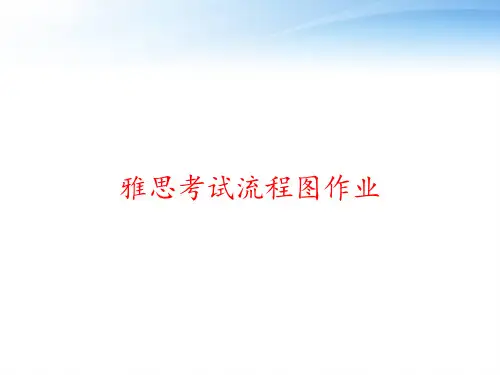
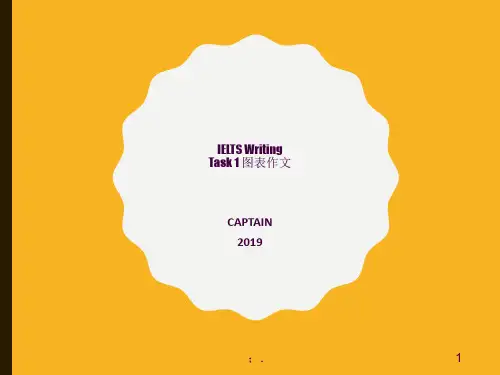
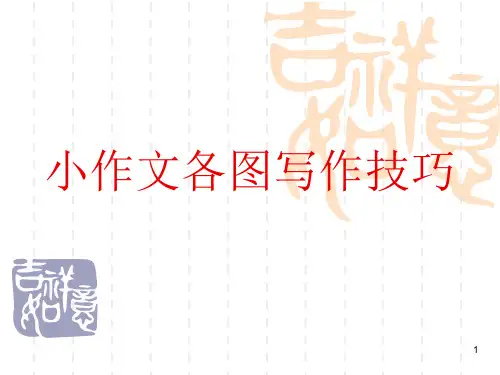
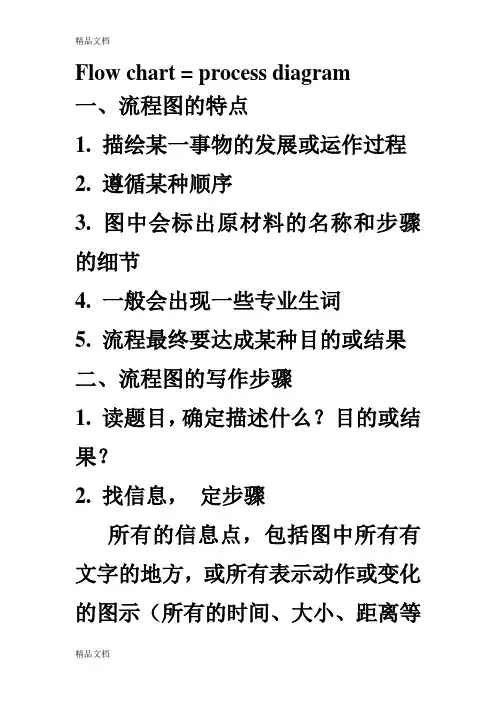
Flow chart = process diagram一、流程图的特点1. 描绘某一事物的发展或运作过程2. 遵循某种顺序3. 图中会标出原材料的名称和步骤的细节4. 一般会出现一些专业生词5. 流程最终要达成某种目的或结果二、流程图的写作步骤1. 读题目,确定描述什么?目的或结果?2. 找信息,定步骤所有的信息点,包括图中所有有文字的地方,或所有表示动作或变化的图示(所有的时间、大小、距离等数字信息)1.定框架,写文章第一段:介绍流程图是做什么的。
第二段:详细介绍原料与准备、每一步的变化、过程及结果。
第三段:简单总结2.读文章,做检查单词拼写、语法、替换重复的词汇等。
三.流程图常用的表达1. The flow chart illustrates the recycling process of _____.2. The process of ____ involves the following steps.3. The whole procedure of ___ can be categorised into ____ stages.4. The row materials for ____ include ___, ___ and ____.5. The first step is to ______.6. ____ with ____ is prepared to _____.7. ____ is used as ____ of ____.8. _____ is mixed with ____ to produce _____.9. _____ can change into ____, when ____.10. The process of ____ is really a simple(complicated) process.The pictures below show the recycling process of wasted glass bottles.As is displayed in the flow chart, the recycling process of glass is really a complex one.The overall process can be categorised=classified=divided into three stages.First, glass products in various forms are gathered=assembled in the Collection point, so that they are easily transported by special trucks or vans to the Cleaning plant, where they get sterilisation byhigh-pressured water. There are three different channels in the Recycling plant, namely Brown, Green and Clear, which represent the colors of glass. After recycled in the furnace, glass products are melted=forged into recycled liquid glass. Mixed with new liquid glass, the compound is finally moulded into solid glass, which, afterwards, will be sent to various customer supermarkets for selling. Thus, the glass will go to the customers for different purposes.Through a brief introduction of the circle of glass recycling, we come to realize that recycling plays a vital role inenvironmental protection and ecological preservation.The diagram below describes how to recycle organic waste to produce compost(fertilizer).1. The flow chart illustrates the recycling process of organic waste toproduce fertilizer.As is clearly shown in the picture, the first step is to find a plastic container of two cubic metres and stab several holes on its body so that air could fill in. Secondly, a 15cm thick layer of food is placed at the bottom of the container and grass is put just above the layer for the same height with some news paper covered on the very top. After that, some nitrogen and water are added into the container, and the water should only be hot. Finally, the container is sealed up and the external heat would help the formation of the compost. After six months, when the fertilizer is ready, all we have to do is to pour it into garden soil to nourish plants and flowers.Generally speaking, making garden fertilizer in this way is easy to operate but it costs much time.2. The flow chart shows the whole process of producing fertilizer by recycling organic waste.Firstly, a two cubic metres plastic container is prepared, with some air holes on its body. Secondly, some organic waste is put into the plastic container. The organic waste includes news paper, grass and food. The right order of adding them is putting food in the bottom 15cm of the container and grass in the middle 15cm upon food. News paper is on the very top. Then nitrogen and water are added into the container. What should be noticed isthat water can only be hot water. The next step is to seal up and heat the container. After six months, compost is produced. So we can use them to fertilize the garden.As can be seen from the picture, it is usually simple to change organic waste into fertilizer used to water flowers and trees in the garden.3. The information provided in the diagram is about how to use organic waste to produce compost in the following several simple stages.The first stage is to prepare a plastic container, two cubic metres in volume, with some ventilation holes on the side.Then organic waste such as leaves, pieces of paper and residues can be placed into the container so that three layers (each 15 cm) can be formed in the bottom---news paper, grass and food respectively from up to down. The next important step is to add nitrogen into it and then pour hot water only in to mix together. What is remembered to do next is that the container needs to be sealed and heated. As a result, the vapor can be emitted through the holes located on its body. After that it takes roughly six months to convert into composts and then they are ready for fertilizing plants and flowers in the garden.。
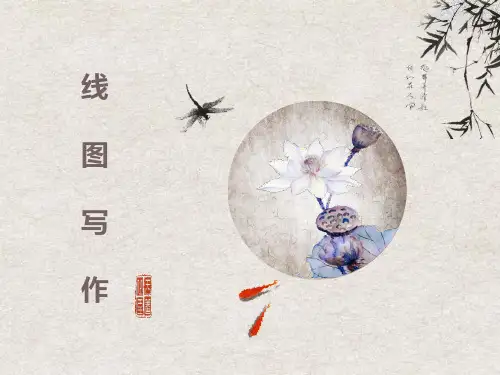
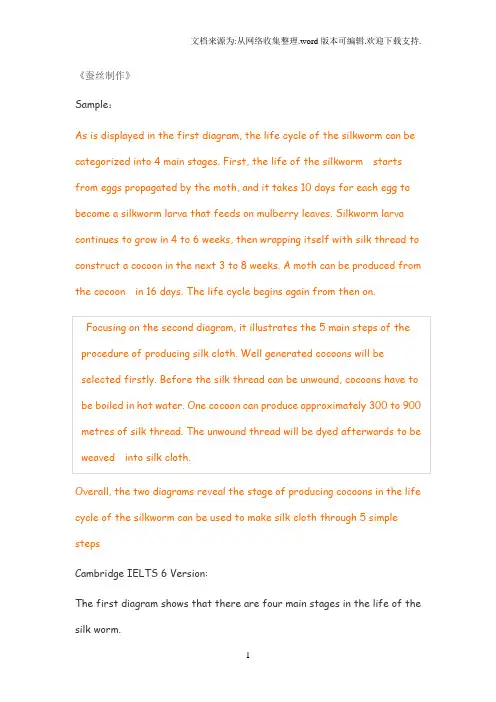
《蚕丝制作》Sample:As is displayed in the first diagram, the life cycle of the silkworm can be categorized into 4 main stages. First, the life of the silkworm starts from eggs propagated by the moth, and it takes 10 days for each egg to become a silkworm larva that feeds on mulberry leaves. Silkworm larva continues to grow in 4 to 6 weeks, then wrapping itself with silk thread to construct a cocoon in the next 3 to 8 weeks. A moth can be produced from the cocoon in 16 days. The life cycle begins again from then on.Overall, the two diagrams reveal the stage of producing cocoons in the life cycle of the silkworm can be used to make silk cloth through 5 simple stepsCambridge IELTS 6 Version:The first diagram shows that there are four main stages in the life of the silk worm.First of all, eggs are produced by the moth and it takes ten days for each egg to become a silkworm larva that feeds on mulberry leaves. This stage lasts for up to six weeks until the larva produces a cocoon of silk thread around itself. After a period of about three weeks, the adult moths eventually emerge from these cocoons and the life cycle begins again. The cocoons are the raw material used for the production of silk cloth. Once selected, they are boiled in water and the threads can be separated in the unwinding stage. Each thread is between 300 and 900 metres long, which means they can be twisted together, dyed and then used to produce cloth in the weaving stage.Overall, the diagrams show that the cocoon stage of the silkworm can be used to produce silk cloth through a very simple process.《玻璃的再生》范文:As is displayed in the flow chart, the recycling process of glass is really a complex one.The overall process can be categorized into 3 stages. First, glass products in various forms are gathered in the Collection point, so that they are easily transported by special trucks or vans to the Cleaning plant, where they get sterilization by high-pressured water. There are three differentchannels in the Recycling plant, namely Brown, Green and Clear, which represent the colors of glass. After recycled in the furnace , glass products are melted into recycled liquid glass. Mixed with new liquid glass, the compound is finally moulded into solid glass, which, afterwards, will be sent to various customer supermarkets for selling. Thus, the glass will go to the customers for different purposes.Through a brief introduction of the circle of glass recycling, we come to realize that recycling plays a vital role in environmental protection and ecological preservation.water filter:The digram illustrates the complete process of water filtering . As can be seen from the flow chart, the gathering procedure of water purifying is similar to the water evaporation.The first step is to prepare a large container with several green plans and a small bottle on the middle of the bottom. Then, a piece of plastic sheet on the plane of the mouth of the bigger container. In order to prevent the plastic film from moving, four stones are placed on each edges respectively.After the preparation, the device can produce the clean water. Thanks to the sunlight shining, the vapor from the green plants rises up to the atmosphere and alters to liquid that accumulates on the lowest point of the plastic coating when it meets the cool air. Subsequently, the pure water drops into the bottom container directly, the pure water collection is accomplished via the principle of evaporation of green plants.《户外取水》范文:The chart describes how water is obtained outdoors.According to the figure, the first step of obtaining water outdoors is to find a hole with green plants on its bottom. Next, remove the green plants in the middle and put a container there. Then, cover the hole with a plastic sheet and place two stones on both ends of it to secure its position. A third stone is laid on the middle of the plastic sheet so that the middle part is also the lowest part.When the sun shines on the green plants in the hole, water evaporates from these plants. The vapor rises up and then cools down to form water drops on the plastic sheet. When there is more and more water, it flows along the sheet to accumulate on the lowest part. Finally, water falls down into the container directly under the middle stone.Thus, water is collected successfully through evaporation from green plants.《房屋不同季节的构造》范文:As is displayed in the flow chart, the principles of insulation in cool and warm climate respectively differ to a large extent.As to the situation of cool climate, we adopt the high-angled roof in order to be nearly parallel with the direction of the sun so that the direct exposition to the heat of sun is lessened as much as we can. By this, the temperature of the material won’t fluctuate within a large range. Meanwhile, thermal building material could enhance the heat storage insulation, preventing outflow, thus reduction of heat.Adversely, in warm climate, reflective building material is indispensable with overhands for shade. The direction of the roof is almost vertical to the direction of the sun to lead to external insulation reflection. By this, ventilation would result in the removal of heat storage rather thanreduction.Through the different working principles of ventilation, we are fascinated by the masterpieces of modern science and technology.《超市建造地点选择》范文:As is unfolded in the map, Place M and N have their unique pros and cons as to the place for building the supermarket.First of all, Place N is located in the urban area of the G town, which may have more population and business. This advantage is incomparable with Place M. What’s more, Main road runs across the center area with convenience in traffic and logistics for the market afterwards. However, the place is equally far away from the neighborhood and the suburb area and cannot attract the residents in the outskirts.As a double-edged sword, Place M is more specifically customer-oriented. In spite of its comparably remote location with Place N, it would attract more customers in the outskirts, for they are reluctant to make a long trip for shopping. On the other hand, the train line nearby will also bring convenience in traffic to the urban -dwellers. Situated to the north-west of Place N, Place M is near the A and B Town with total population of 23 million, far outnumbering the overall population of D and E town, with 12 million.What’s worthy of being mentioned is that fierce competition in Place N and probable monopoly in Place M should also be taken into account when building the supermarket.《化肥的制作》范文:As is shown in the flow chart, the process of recycling organic waste to produce compost is really a complex one.The whole process can be categorized into five stages . First of all, prepare a plastic container which has four holes for ventilating the air. There is a rule when putting waste into the container, food at the bottom within 15 centimeters high, grass at the middle and newspaper at the top within 15 centimeters high altogether, in order to make a optimum (appropriate) environment for different bacteria细菌reproducing. In the following stage, we can witness nitrogen氮and water being put into the container. What's worth mentioning is that water is only added in a hot weather. Next, heat the waste and let the bacteria reproduce fastly, with which the organic waste can be decomposed and became garden fertiliser after 6 months. Subsequently, we can carry the compost out and move it to the garden, thus a new recycling can begin.In conclusion, using this way to turn the organic waste into garden fertiliser 化肥is environmentally friendly. By enlarging the number orvolume of the container, we can dispose more waste at the same time.。
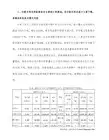
《蚕丝制作》Sample:As is displayed in the first diagram, the life cycle of the silkworm can be categorized into 4 main stages. First, the life of the silkworm starts from eggs propagated by the moth, and it takes 10 days for each egg to become a silkworm larva that feeds on mulberry leaves. Silkworm larva continues to grow in 4 to 6 weeks, then wrapping itself with silk thread to construct a cocoon in the next 3 to 8 weeks. A moth can be produced from the cocoon in 16 days. The life cycle begins again from then on.Focusing on the second diagram, it illustrates the 5 main steps of the procedure of producing silk cloth. Well generated cocoons will be selected firstly. Before the silk thread can be unwound, cocoons have to be boiled in hot water. One cocoon can produce approximately 300 to 900 metres of silk thread. The unwound thread will be dyed afterwards to be weaved into silk cloth.Overall, the two diagrams reveal the stage of producing cocoons in the life cycle of the silkworm can be used to make silk cloth through 5 simple stepsCambridge IELTS 6 Version:The first diagram shows that there are four main stages in the life of the silk worm.First of all, eggs are produced by the moth and it takes ten days for each egg to become a silkworm larva that feeds on mulberry leaves. This stage lasts for up to six weeks until the larva produces a cocoon of silk thread around itself. After a period of about three weeks, the adult moths eventually emerge from these cocoons and the life cycle begins again. The cocoons are the raw material used for the production of silk cloth. Once selected, they are boiled in water and the threads can be separated in the unwinding stage. Each thread is between 300 and 900 metres long, which means they can be twisted together, dyed and then used to produce cloth in the weaving stage.Overall, the diagrams show that the cocoon stage of the silkworm can be used to produce silk cloth through a very simple process.《玻璃的再生》范文:As is displayed in the flow chart, the recycling process of glass is really a complex one.The overall process can be categorized into 3 stages. First, glass products in various forms are gathered in the Collection point, so that they are easily transported by special trucks or vans to the Cleaning plant, where they get sterilization by high-pressured water. There are three different channels in the Recycling plant, namely Brown, Green and Clear, which represent the colors of glass. After recycled in the furnace , glass products are melted into recycled liquid glass. Mixed with new liquid glass, the compound is finally moulded into solid glass, which, afterwards, will be sent to various customer supermarkets for selling. Thus, the glass will go to the customers for different purposes.Through a brief introduction of the circle of glass recycling, we come to realize that recycling plays a vital role in environmental protection and ecological preservation.water filter:The digram illustrates the complete process of water filtering . As can be seen from the flow chart, the gathering procedure of water purifying is similar to the water evaporation.The first step is to prepare a large container with several green plans and a small bottle on the middle of the bottom. Then, a piece of plastic sheet on the plane of the mouth of the bigger container. In order to prevent the plastic film from moving, four stones are placed on each edges respectively.After the preparation, the device can produce the clean water. Thanks to the sunlight shining, the vapor from the green plants rises up to the atmosphere and alters to liquid that accumulates on the lowest point of theplastic coating when it meets the cool air. Subsequently, the pure waterdrops into the bottom container directly, the pure water collection is accomplished via the principle of evaporation of green plants.《户外取水》范文:The chart describes how water is obtained outdoors.According to the figure, the first step of obtaining water outdoors is to find a hole with green plants on its bottom. Next, remove the green plants in the middle and put a container there. Then, cover the hole with a plastic sheet and place two stones on both ends of it to secure its position. A third stone is laid on the middle of the plastic sheet so that the middle part is also the lowest part.When the sun shines on the green plants in the hole, water evaporates from these plants. The vapor rises up and then cools down to form water drops on the plastic sheet. When there is more and more water, it flows along the sheet to accumulate on the lowest part. Finally, water falls down into the container directly under the middle stone.Thus, water is collected successfully through evaporation from green plants.《房屋不同季节的构造》范文:As is displayed in the flow chart, the principles of insulation in cool and warm climate respectively differ to a large extent.As to the situation of cool climate, we adopt the high-angled roof in order to be nearly parallel with the direction of the sun so that the direct exposition to the heat of sun is lessened as much as we can. By this, the temperature of the material won’t fluctuate within a large range. Meanwhile, thermal building material could enhance the heat storage insulation, preventing outflow, thus reduction of heat.Adversely, in warm climate, reflective building material is indispensable with overhands for shade. The direction of the roof is almost vertical to the direction of the sun to lead to external insulation reflection. By this, ventilation would result in the removal of heat storage rather than reduction.Through the different working principles of ventilation, we are fascinated by the masterpieces of modern science and technology.《超市建造地点选择》范文:As is unfolded in the map, Place M and N have their unique pros and cons as to the place for building the supermarket.First of all, Place N is located in the urban area of the G town, which may have more population and business. This advantage is incomparable with Plac e M. What’s more, Main road runs across the center area with convenience in traffic and logistics for the market afterwards. However, the place is equally far away from the neighborhood and the suburb area and cannot attract the residents in the outskirts.As a double-edged sword, Place M is more specifically customer-oriented. In spite of its comparably remote location with Place N, it would attract more customers in the outskirts, for they are reluctant to make a long trip for shopping. On the other hand, the train line nearby will also bring convenience in traffic to the urban -dwellers. Situated to the north-west of Place N, Place M is near the A and B Town with total population of 23 million, far outnumbering the overall population of D and E town, with 12 million.What’s worthy of being mentioned is that fierce competition in Place N and probable monopoly in Place M should also be taken into account when building the supermarket.《化肥的制作》范文:As is shown in the flow chart, the process of recycling organic waste to produce compost is really a complex one.The whole process can be categorized into five stages . First of all, prepare a plastic container which has four holes for ventilating the air. There is a rule when putting waste into the container, food at the bottom within 15 centimeters high, grass at the middle and newspaper at the top within 15 centimeters high altogether, in order to make a optimum (appropriate) environment for different bacteria细菌reproducing. In the following stage, we can witness nitrogen氮and water being put into the container. What's worth mentioning is that water is only added in a hot weather. Next, heat the waste and let the bacteria reproduce fastly, with which the organic waste can be decomposed and became garden fertiliser after 6 months. Subsequently, we can carry the compost out and move it to the garden, thus a new recycling can begin.In conclusion, using this way to turn the organic waste into garden fertiliser 化肥is environmentally friendly. By enlarging the number or volume of the container, we can dispose more waste at the same time.。

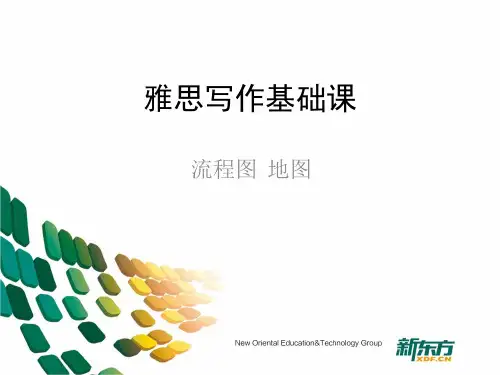
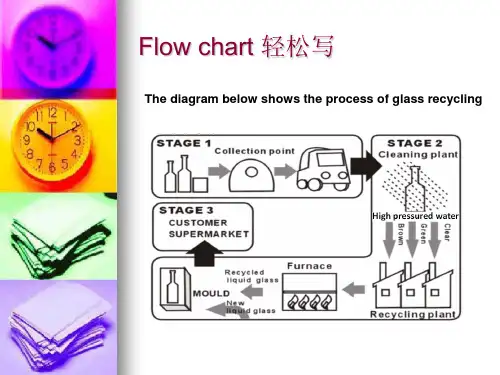
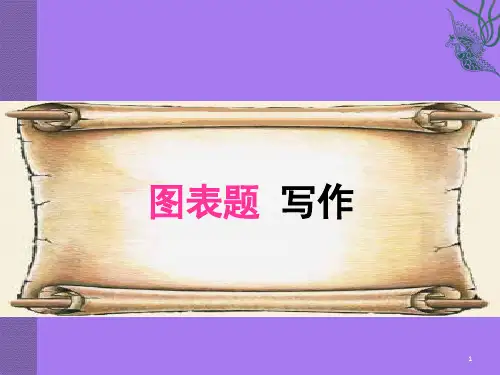
Flow chart = process diagram一、流程图的特点1. 描绘某一事物的发展或运作过程2. 遵循某种顺序3. 图中会标出原材料的名称和步骤的细节4. 一般会出现一些专业生词5. 流程最终要达成某种目的或结果二、流程图的写作步骤1. 读题目,确定描述什么?目的或结果?2. 找信息,定步骤所有的信息点,包括图中所有有文字的地方,或所有表示动作或变化的图示(所有的时间、大小、距离等数字信息)1.定框架,写文章第一段:介绍流程图是做什么的。
第二段:详细介绍原料与准备、每一步的变化、过程及结果。
第三段:简单总结2.读文章,做检查单词拼写、语法、替换重复的词汇等。
三.流程图常用的表达1. The flow chart illustrates the recycling process of _____.2. The process of ____ involves the following steps.3. The whole procedure of ___ can be categorised into ____ stages.4. The row materials for ____ include ___, ___ and ____.5. The first step is to ______.6. ____ with ____ is prepared to _____.7. ____ is used as ____ of ____.8. _____ is mixed with ____ to produce _____.9. _____ can change into ____, when ____.10. The process of ____ is really a simple(complicated) process.The pictures below show the recycling process of wasted glass bottles.As is displayed in the flow chart, the recycling process of glass is really a complex one.The overall process can be categorised=classified=divided into three stages.First, glass products in various forms are gathered=assembled in the Collection point, so that they are easily transported by special trucks or vans to the Cleaning plant, where they get sterilisation byhigh-pressured water. There are three different channels in the Recycling plant, namely Brown, Green and Clear, which represent the colors of glass. After recycled in the furnace, glass products are melted=forged into recycled liquid glass. Mixed with new liquid glass, the compound is finally moulded into solid glass, which, afterwards, will be sent to various customer supermarkets for selling. Thus, the glass will go to the customers for different purposes.Through a brief introduction of the circle of glass recycling, we come to realize that recycling plays a vital role in environmental protection and ecological preservation.The diagram below describes how to recycle organic waste to produce compost(fertilizer).1. The flow chart illustrates the recycling process of organic waste to produce fertilizer.As is clearly shown in the picture, thefirst step is to find a plastic container of two cubic metres and stab several holes on its body so that air could fill in. Secondly, a 15cm thick layer of food is placed at the bottom of the container and grass is put just above the layer for the same height with some news paper covered on the very top. After that, some nitrogen and water are added into the container, and the water should only be hot. Finally, the container is sealed up and the external heat would help the formation of the compost. After six months, when the fertilizer is ready, all we have to do is to pour it into garden soil to nourish plants and flowers.Generally speaking, making garden fertilizer in this way is easy to operate but it costs much time.2. The flow chart shows the wholeprocess of producing fertilizer by recycling organic waste.Firstly, a two cubic metres plastic container is prepared, with some air holes on its body. Secondly, some organic waste is put into the plastic container. The organic waste includes news paper, grass and food. The right order of adding them is putting food in the bottom 15cm of the container and grass in the middle 15cm upon food. News paper is on the very top. Then nitrogen and water are added into the container. What should be noticed is that water can only be hot water. The next step is to seal up and heat the container. After six months, compost is produced. So we can use them to fertilize the garden.As can be seen from the picture, it isusually simple to change organic waste into fertilizer used to water flowers and trees in the garden.3. The information provided in the diagram is about how to use organic waste to produce compost in the following several simple stages.The first stage is to prepare a plastic container, two cubic metres in volume, with some ventilation holes on the side. Then organic waste such as leaves, pieces of paper and residues can be placed into the container so that three layers (each 15 cm) can be formed in the bottom---news paper, grass and food respectively from up to down. The next important step is to add nitrogen into it and then pour hot water only in to mix together. What is remembered to do next is that the container needs to besealed and heated. As a result, the vapor can be emitted through the holes located on its body. After that it takes roughly six months to convert into composts and then they are ready for fertilizing plants and flowers in the garden.。